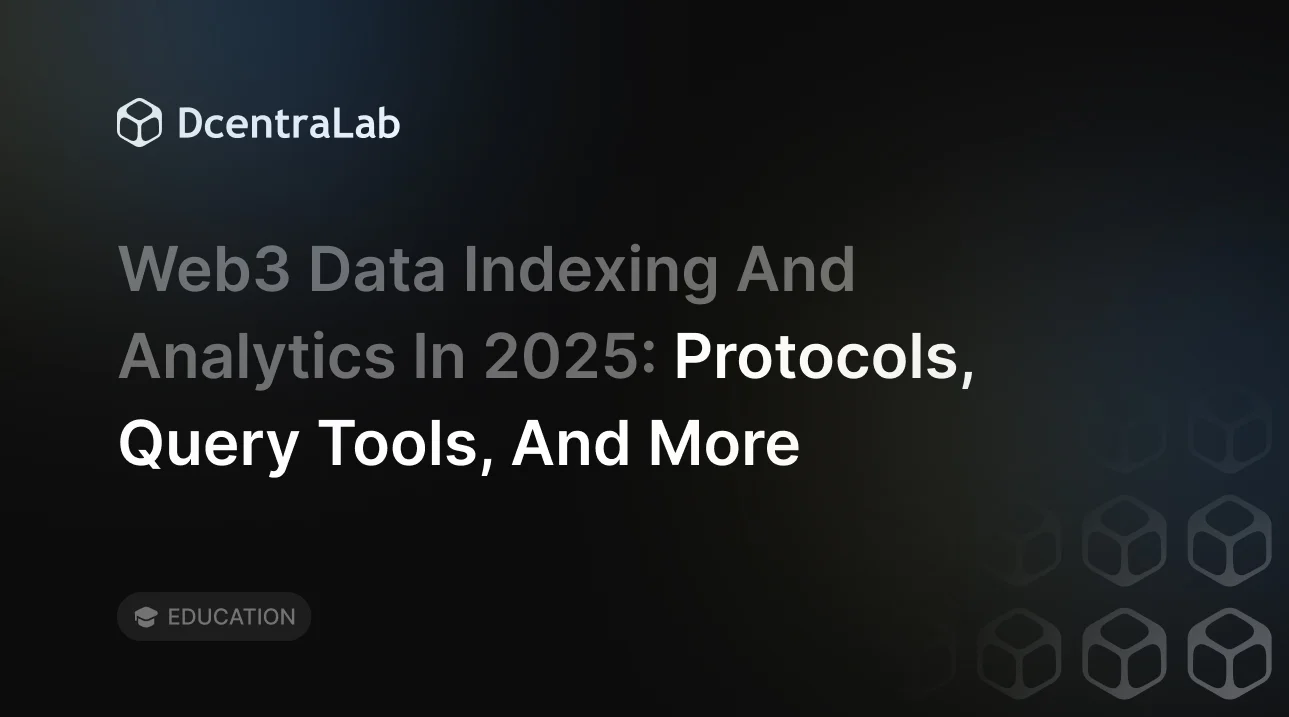Web3 Data Indexing and Analytics in 2025: Protocols, Query Tools, and More

tl;dr
- Web3 shifts data storage from centralized servers to decentralized ledgers, introducing new opportunities and challenges.
- On-chain data growth is massive, with Ethereum archive nodes exceeding 13 TB and indexers processing hundreds of terabytes.
- Real-time querying and analytics are essential for scalable, high-performance dApps.
- Web3 indexing enables rapid, cross-chain data access through protocols like The Graph, SubQuery, and Covalent.
Introduction to Web3 Data Indexing and Analytics
Web3 fundamentally transforms digital infrastructure by moving data from centralized servers to decentralized ledgers. This move introduces new opportunities as well as challenges in accessibility, scalability, and data analysis for dApps.
The exponential rise in on-chain activity has led to unprecedented growth in blockchain data: Ethereum archive nodes now store over 13 TB of historical data, and major Web3 indexers process hundreds of terabytes collectively. The amount of data makes real-time querying and analytics vital for dApp performance and user experience.
This article explores the paradigm shift in decentralized data, the scale of on-chain data growth, and how Web3 data indexing enables rapid, protocol-agnostic access across chains. We’ll cover leading tools like The Graph, Chainbase, and Dune Analytics, AI-driven multi-chain analytics, and real-world DeFi and cross-chain use cases.
Discover why blockchain analytics are essential infrastructure for the next generation of dApps.
Key Indexing Protocols in Web3
Web3 indexing protocols organize and make blockchain data easily accessible for developers, enabling decentralized applications to retrieve information quickly and reliably. Dive into protocols like The Graph, SubQuery, and Covalent, which enable data querying through subgraphs and APIs.
The Graph: Decentralized Querying with GraphQL
The Graph uses GraphQL to allow developers to query blockchain data efficiently through subgraphs, ensuring decentralization and transparency across ecosystems like Ethereum and Polygon.
SubQuery: Multi-Chain Support for Custom APIs
SubQuery provides multi-chain data indexing with flexible APIs tailored for specific project needs. It also integrates with AI-driven tools, making it ideal for analytics and DAO governance.
Emerging Protocols: Like DeScan for Censorship Resistance
DeScan introduces censorship-resistant indexing, focusing on open, permissionless access to blockchain data. This indexing is key for search engines and decentralized applications.

Top Tools for Data Querying and Analysis
Web3 analytics tools simplify blockchain data exploration through intuitive dashboards, APIs, and SDKs for seamless dApp integration.
Dune Analytics: SQL-Based Dashboards
Dune empowers users to write SQL queries and create interactive dashboards tracking DeFi, NFT, and token metrics across major chains.
Nansen: Wallet Labeling and AI Insights
Nansen combines AI-driven wallet labeling with powerful analytics, offering deep behavioral insights for investors and protocols.
Arkham: Real-Time Transaction Monitoring
Arkham provides real-time blockchain intelligence, detecting large movements, patterns, and potential exploits instantly.
The Role of Indexing and Analytics in dApp Development
Indexing and analytics are vital pillars of dApp development, enabling decentralized applications to offer real-time insights, automation, and seamless user experiences. By transforming raw on-chain data into structured, queryable formats through APIs or GraphQL, blockchain indexers eliminate the need for resource-heavy node queries and power instant dashboards, yield optimization tools, and compliance systems.
Real-Time Features Enabled by Indexing
Indexers like The Graph and SubQuery allow dApps to display live user dashboards, updating holdings, transactions, or governance activity as blocks confirm. They also support automated compliance, tracking smart contract events, and validating addresses to enforce KYC or AML rules.
Key Use Cases
From DeFi yield optimization and NFT marketplace insights to multi-chain aggregation, indexers empower real-time decision-making and enhance cross-chain interoperability.
Boosting dApp Efficiency
Efficient querying and rapid data synchronization free developers from backend complexities, fostering faster, data-rich, and more interactive decentralized experiences.
Best Practices for Implementing Web3 Data Solutions
Designing efficient Web3 data systems requires careful planning, scalability, and consistent optimization. Developers should:
• Use modular components for scalable infrastructure across chains.
• Design efficient schemas to minimize redundancy and improve retrieval speed.
• Optimize queries for faster data access and lower resource use.
• Integrate AI for predictive analytics and anomaly detection.
• Perform regular index maintenance to ensure accuracy and freshness.
Implementation Checklist:
1. Define data goals and sources.
2. Choose indexers and APIs.
3. Build modular schema design.
4. Test query performance.
5. Automate updates and monitoring.
Challenges in Blockchain Data Management
Blockchain data management faces hurdles such as scalability, data accuracy, and interoperability, which can limit dApp performance and user experience. As networks grow, massive data volumes strain queries, while fragmented ecosystems complicate analytics.
Solutions include efficient indexing engines, cross-chain analytics, and zero-knowledge proofs to balance transparency and privacy. Leveraging decentralized infrastructure also improves cost efficiency and reliability across chains.



